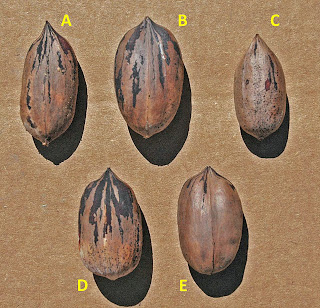Over the past several days, I've been in a hydraulic lift collecting pecans from our pecan breeding plot (photo at right). Moving from tree to tree, it is amazing to witness the genetic diversity of pecan. Fortunately, we used early maturing parents for this project and now, 15 years later, most of the trees in this planting have ripened their nuts by the first week of October (not all though).
As you might expect, I have found nuts of all sizes and shapes. Some have thin shells. Some will need a sledge hammer to crack them open. In addition, there are huge differences in reaction to leaf and nut diseases. After looking at so many seedling pecan trees with such diverse sets of cultivar traits, I now have a greater appreciation of how rare it is to find a truly exception new pecan.
Today, I collected nuts from five different trees just to give you an idea of the type of variation I am seeing in our breeding plot (photo at left). All of these nuts had achieved shuck split with nut "E" probably splitting the earliest. I choose these five pecans because they were roughly the same size in the shuck. When pulling these nuts from the tree, these five nuts appeared to be fairly large. But looks can be deceiving.
In the photo at right, you can see the same five nuts pulled out of their shucks. The differences in size and shape are obvious. A big shuck doesn't always produce a big nut (nut C) and surprisingly large nuts can fall from not-so-impressive shucks (nut E).
The shuck is only the first cover that needs to be peeled back to reveal a pecan's true character. The second cover is the shell. In the photo at left, I've arranged the same five nuts in the same order, but this time, each nut is cut in cross section. Note the differences in shell thickness. Nut "A" has the thinnest shell, while nuts "D" and "C' have heavy shells. Now look at the packing material as it dips down into the dorsal groves of each kernel half. Long narrow dorsal groves means that the packing material might get stuck in the kernel during the cracking process. Nuts "C" and "E" might have a problem in this regard.
Overall nut quality for 2013 looks great. You can look forward to seeing all the nuts we collect this year from the pecan breeding plot on display at the nut exhibits held in conjunction with the KS, MO and IL nut growers annual meetings early next year.



